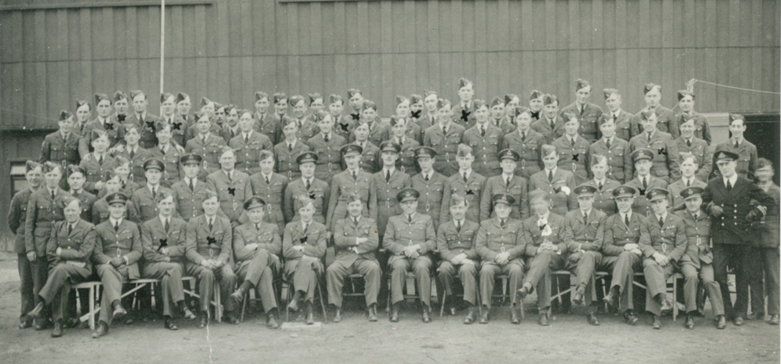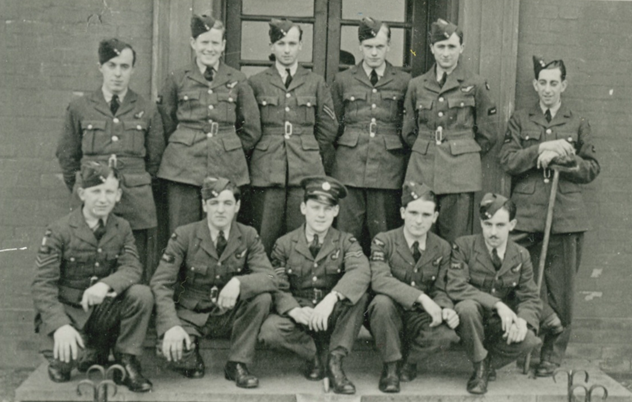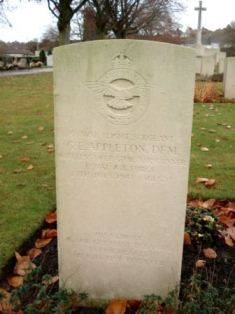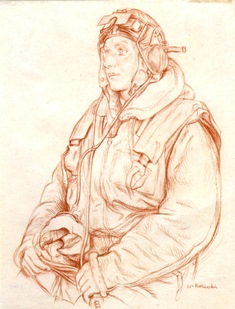Appleton, George Edward D.F.M. (548102)
George Edward Appleton was born in Newcastle-upon-Tyne in 1920. He enlisted in the RAF on 24th January 1938 (service number 548102). Following training as an Aircraft Hand Wireless Operator he was posted to 49Sqn as an Aircraft man (A.C 1).
49Sqn had re-formed as a light-bomber squadron from 18Sqn ‘C’ Flight on 10th February 1936 at Bircham Newton, Norfolk with Hind’s. The squadron moved to Worthy Down, Hants on 8th August before re-locating to Scampton, Lincs on 14th March 1938 to re-equip with Hampden I’s, the first unit to do so.

49Sqn Group photo
Appleton’s first operation was on 21st December 1939, a mission to locate the German Battleship – Deutchland. Flying in Hampden I L4093 the operation was unsuccessful however on the return trip the Squadron was approached by some enemy aircraft, but luckily not engaged. Promoted to Leading Aircraftman, Appleton next flew operationally in the Squadron C.O's aircraft on a nickelling (leaflet-dropping) trip on 18th January 1940. Continuing to fly on a regular basis throughout that winter, he became a permanent crew member in Squadron Leader Geoffrey Lowe's aircraft and gained promotion to Corporal.
On 14th April 1940 three 49Sqn Hampden aircraft were tasked along with twenty-five Hampdens from other squadrons with a gardening (minelaying) operation off Denmark. This was only the second minelaying operation of the war. Sqn/Ldr Lowe and crew were assigned Hampden I L4043, F/O Forsyth and F/Lt Mitchell skippered the other 49Sqn Hampden’s.
Hampden I L4043 was built by the Handley Page Co at the Cricklewood factory and delivered between August 1938 and June 1939. It was one of the first production batch of 180 Hampden aircraft.
Taking off from Scampton at 19:00 in 5 minute intervals the aircraft headed towards the West Baltic area to drop their mines, but bad weather intervened and prevented the vegetables (mines) from being planted. Both F/O Forsyth and F/Lt Mitchell returned to base safely, but S/Ldr Lowe and crew were experiencing severe difficulties. Lowe reported the following:
"We did not lay our mines due to bad weather which rapidly deteriorated on the way home. I was having trouble with all my flying instruments but the compass and turn and bank indicators were still working. Eventually we managed to make contact with Hemswell and they gave us a bearing which proved to be inaccurate. Shortly after crossing the coast an aerodrome was sighted flashing a red 'D'. We were unable to get a response so decided to send an 'SOS' on the Aldis lamp... again nothing happened... we then fired a red Very light and this time searchlights came on to the north of us."
S/Ldr Lowe made for the searchlights with the intention of being 'brought in' by them. One engine then failed due to fuel starvation but they managed to maintain height on the other. When this engine started to spit and cough the captain offered his crew the option to bale out – no one wished to jump. The aircraft was rapidly becoming uncontrollable and the captain decided to force land on the coastline; the pilot continues:
"I instructed the crew to collect in the compartment behind the pilot’s seat. I held off as long as possible but the aircraft swung violently towards the cliffs and rocks below. I managed to correct this slightly, but not enough to clear a line of rocks running out into the sea. When I was holding off and practically stalling, I pulled the nose up and landed on a tail slide with very little speed."
The Hampden crashed at about 04.00hrs (or 00:30?) on a beach near Ryhope, south of Sunderland. P/O Anthony Bryan-Smith was attempting to join the other two members of the crew amidships when the aircraft crash landed. He was only half-way through the rear door and was killed immediately. The navigator, P/O Kennet Henry Penrith Beauchamp received slight cuts on the hand, Appleton bumped his head and was slightly concussed and the pilot escaped with a cut lip. P/O Bryan-Smith was buried at Hylton (Castletown) Cemetery.

Appleton and crew
Advanced to Sergeant, Appleton was back in action just two weeks later. Subsequent operations included trips to Amiens, Brest and the Island of Texel in the Netherlands. He was gazetted for a Distinguished Flying Medal on 19 July 1940. The official recommendation submitted by Air Vice Marshal A. T. Harris, stated:
“This N.C.O. Wireless Operator/ Air Gunner has undertaken 13 long operational flights over enemy territory, many of them in very bad weather and under conditions of considerable difficulty. As the senior Wireless Operator/ Air Gunner in his Squadron he has invariably displayed resourcefulness, coolness and determination in the face of the enemy, great efficiency as a Wireless Operator/ Air Gunner and has set a fine example.”
Appleton went on to complete a total of 24 operational missions before being posted to the Central Gunnery School at Castle Kennedy, Wigtownshire in late 1940.
 |
Tragically on 27th July 1941 he paid the ultimate sacrifice when the Hampden I (P1162) in which he was Air Gunner for camera gun trials stalled in a turn shortly after take-off and crashed at 10.32 killing all five crew members. Appleton was just 20 and is interred in the West Road Cemetery, Newcastle on Tyne (Section. R. Grave 281). His final promotion to Flight Sergeant came through after his death. |
 |
“Men of The R.A.F” by Sir William Rothenstein and Lord David Cecil, published in 1942 contains a portrait of Appleton |
